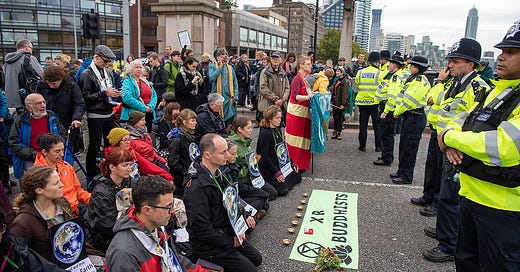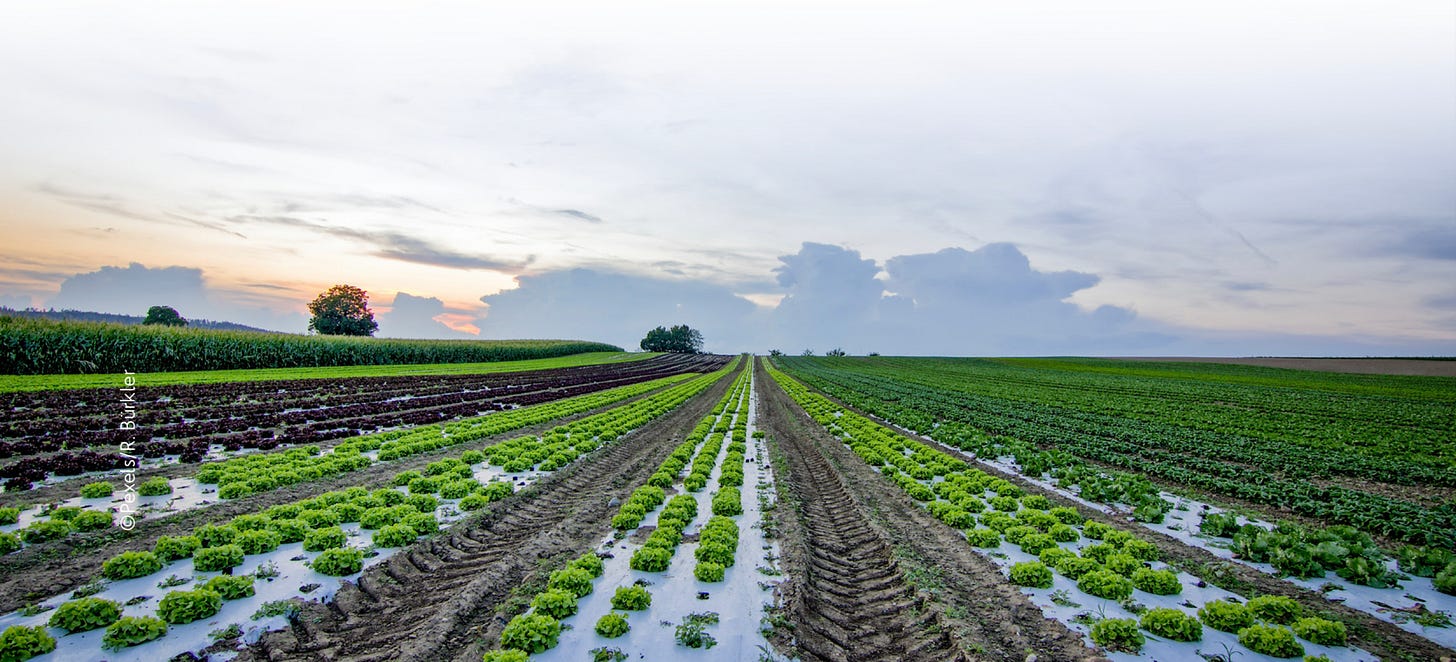8 April 2022. XR | Plastics
Juries are reluctant to convict XR protestors. Plastics are everywhere—now found for the first time in the human bloodstream.
Welcome to Just Two Things, which I try to publish daily, five days a week. Some links may also appear on my blog from time to time. Links to the main articles are in cross-heads as well as the story. Recent editions are archived and searchable on Wordpress.
I’m away next week, but will have some time to write. So you can expect editions of Just Two Things on Monday, and Wednesday—then a break for the Easter holiday.
1: Juries are reluctant to convict XR protestors
The journalist Zoe Blacker has observed all of the seven jury trials of Extinction Rebellion defendants, and has written about it on the LRB blog. She discovered something interesting: juries are really reluctant to convict, even when judges more or less direct them to. And this even though the defendants acknowledged the specific offences they were being tried for, but used as a defence the greater harm of climate change they were trying to prevent. As she notes, at a trial in Shadwell in January,
the jury was presented with two sets of undisputed facts:
1) At 6:45 a.m. on 17 October 2019, a female vicar in her late seventies, accompanied by a male vicar in his fifties, used a retractable ladder to climb onto the roof of a train they had just left while another man in his eighties superglued his hand to the outside of the carriage. Members of the public expressed irritation, before police arrived to remove them and the train was returned to service.
2) The scientific consensus on the effects of rising carbon emissions includes: collapsing ecosystems; increasing frequency and severity of extreme weather events, primarily in the Global South with the North starting to feel the effects; large parts of the world set to become uninhabitable; and the inadequacy of the predictions themselves, as earth’s systems come closer to irreversible tipping points.
In this particular case, the jury returned a unanimous verdict within two hours.
(Blocking of Lambeth Bridge, 2019. Photo by Stefan Muller/flickr, CC BY 2.0)
There are two or three interesting points here.
The first is that in English law, the jury’s decision is final, even if it goes against the law. This is a principle that goes back to the 17th century, when a London jury that refused to convict the Quaker William Penn was imprisoned by the judge. FN This is the same William Penn who founded Pennsylvania. Such judgements are known as “perverse judgments”, and there are other more recent examples. Michael Randle and Paul Pottle, who were prosecuted years after the fact for their part in the escape in 1966 of the spy George Blake from Wormwood Scrubs, were acquitted after the judge had directed to jury to find them guilty.
The second is, as Blacker explains, that there is existing law that offers a defence in these cases. The UK Supreme Court upheld the acquittal of four anti-arms trade protestors on the basis that “a peaceful protest can still be lawful even if ‘deliberately’ disruptive”:
Articles 10 and 11 of the European Convention on Human Rights provide protesters with a ‘lawful excuse’ for offences committed during such a protest. What criminal courts must decide, the Supreme Court justices ruled, is whether a conviction would be a ‘disproportionate interference’ in those rights when balanced against the rights of others.
The third is that some judges have complained that they are in a court of law, not of ‘morality’. But of course, the notion that morality and law are independent domains is a social nonsense. We used to prosecute people for failing in a suicide attempt, but no longer do so, for example.
Not all defendants have been acquitted. One jury found the XR defendants guilty, but told the judge they had done so with great reluctance. At Canning Town, where the public response created a risk of public disorder, the legal position was much less ambiguous, and the judge directed that the jury find them guilty. Even so the foreman of the jury read out a dissenting statement to the court.
It’s also hard to read Blacker’s story without thinking that the jurors are going through a form of deliberative decision-making about climate change, having the arguments put to them and having to weigh them up. Given the low success rate of the prosecutions, the former activist and Labour government minister Peter Hain has suggested that the Crown Prosecution Service should stop taking cases to court,
‘on the grounds that the law readily provides: that they are “not in the public interest”.’
Of course, the British Home Secretary doesn’t share his view. It would be politically difficult for the Crown Prosecution Service to take such a decision. But the result is that there are more trials to come—and very likely, more acquittals.
2: Plastics are everywhere—now found for the first time in the human bloodstream.
The plastics crisis has just taken a turn for the worse. There’s been a set of alarming reports on the extent of plastics in the food system. The American food researcher Marion Nestle has pulled together some recent coverage of this.
The first piece is a scientific article in Environment International that found plastic in human blood systems for the first time:
In this study of a small set of donors, the mean of the sum quantifiable concentration of plastic particles in blood was 1.6 µg/ml, showing a first measurement of the mass concentration of the polymeric component of plastic in human blood. This pioneering human biomonitoring study demonstrated that plastic particles are bioavailable for uptake into the human bloodstream.
The quantity of plastics used in food production and packaging is significant—a fraction under 50 million tonnes a year, according to the FAO. This represents about 14% of annual global plastics consumption.
The reason so much plastic is used in production is because it increases productivity. The same FAO report spells it out (I’m borrowing from Marion Nestle’s reading of it here):
Mulch films, for instance, are used to cover the soil to reduce weed growth, the need for pesticides, fertilizer and irrigation; tunnel and greenhouse films and nets protect and boost plant growth, extend cropping seasons and increase yields.
But mulch films also get contaminated in use, so they can’t be easily recycled afterwards. There’s more in the same vein in the report about production—there’s a lot of plastic used in irrigation drips and tree guards, for example. Cattle ear tags are plastic as well. The list in the report goes on and on.
(Plastic mulch on fields. Image: FAO)
There’s a word for this, in fact: “plasticulture”—according to a recent story in Civil Eats:
The term plasticulture describes the use of plastic products in nearly every facet of agricultural production, from growing seedlings and preventing weed pressure to storing food. It has been touted as a method for increasing crop productivity and improving food security.
And then there’s food packaging, which accounts for three times as much plastic use as food production, and has benefits:
(P)lastic products help reduce food losses and waste, and maintain its nutritional qualities throughout a myriad of value chains, thereby improving food security and reducing greenhouse gas (GHG) emissions.
Finally, the FAO notes that although there’s been lots of coverage of the effect of larger plastic objects on marine life, there’s less knowledge of what happens when plastic is broken down to the cellular level, as it is to wash around in the bloodstream. At that point, they effectively enter the food chain.
Microplastics (plastics less than 5 mm in size) are thought to present specific risks to animal health, but recent studies have detected traces of microplastic particles in human faeces and placentas. There is also evidence of mother-to-foetus transmission of much smaller nanoplastics in rats.
There are lots of bright suggestions in the FAO report about using the 6R model—Reduce, Refuse, Redesign, Reduce, Reuse, Recycle, and Recover—but of course, supply chains are undeveloped and these approaches are not so familiar at the moment.
The bigger problem—if plastic is an ecosystem threat—is that there’s little global agreement yet on doing much about it.
Despite these policy and legal instruments, there are many aspects of the life cycle of plastic products, including those used in agrifood value chains, that remain unaddressed at the global level. This is a major weakness.
This is why the recent United Nations vote on an international plastics treaty was such a big deal. The FAO recommends a whole range of measures, including extended producer responsibility schemes, new standards, improved plastic collections schemes, and some outright bans on some types of plastic.
The Civil Eats article points out that the balance of the discussion of the issue is unbalanced:
“Currently with all the use of plastics in agriculture, the focus is on what benefits they deliver,” said Richard Thompson, a co-author of the (FAO) report. While plastics offer farmers benefits in the form of increased yields and resource efficiency, “there’s very little focus on their potential for harm,” said Thompson.
It’s also one of those issues where short term gains—not just in cost but in productivity—are easy to measure. But the long term risks of plastic everywhere in the ecosystem aren’t understood, but could be disastrous. The fact that we’ve only just seen plastic in human bloodstreams is reminder of how little we know.
Notes from readers
I’ve had some responses to my note this time last week about the gender mix of classical orchestras. Andre Furstenberg was in the audience at the Berliner Symphony just after Sabina Meyer was hired there on the insistence of the conductor von Karajan, who was probably unsackable:
I remember seeing Sabina Meyer, the clarinet player, shortly after the controversy with (the conductor) von Karajan where he insisted that she was hired as one of the first female members of the Berliner Symphony. I recall the whole audience getting up on their chairs for a standing ovation. Her Mozart rendition still sends chills down my spine.
Here’s a recording of her playing Mozart”s Clarinet Concerto:
And at the other end of the cultural spectrum, in pretty much all senses, Huw Williams shared Victoria Wood’s extended sketch—a parody of the film Brassed Off— about her trying to join the brass band in the village where she was born and grew up. Wood arrives about four minutes in:
Have a good weekend.
——————————-
j2t#296
If you are enjoying Just Two Things, please do send it on to a friend or colleague.




